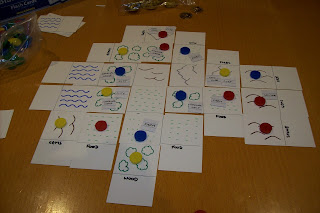In the end we had five volunteers turning up, which made for six of us crammed into my little games room, and we tried out Boogie Knights (which is in a very playable state but has a lot of rough edges to work on) and El Tiddly (which is more of a test-of-concept than actual game right now).
 |
| The most professional looking board for one of my prototypes so far. |
There was loads of good general feedback too. The "magic" equipment that got introduced in version 0.2 is really not working, but some discussion got us ideas for replacement cards/rules (potions or magic scrolls that allow some mischievous moving around of equipment) that should meet the intent of the magic kit (mostly to add a little disruptive fun) in a way that fits the game better. We also found a few other bits of tuning to do.
So, I know what I need to do for version 0.3, so I'd better get on with it.
El Tiddly really didn't work well. For a start, we didn't get enough counters onto the board to make for real competition, and the fact that I had cards allowing people to remove counters (without possibility of failure) meant that the board stayed sparsely populated. There was also a feeling that the tiddlywinks were just too difficult to control (it should be noted that "proper" tiddlywinks has a cup for a target, so the winks don't generally slide on out after hitting the target), and access to different sides of the table to make shots can be a bit of a pain. Apart from that, there was general agreement that there was a lot of downtime between turns (particularly with five players) and what was going on on other people's turns wasn't really fun enough to make up for that.
Overall, then, I think El Tiddly is getting shelved. There were, however, loads of ideas being thrown around as to how it might be possible to make a game like this actually work (from cutting it down to a two-player duelling game to having a contoured board), so I may get back to it at some time. I need a lot of sleeps first, though, and in the meantime I have plenty of other projects to be focusing on.
Thanks again to the fine individuals who came to help with the playtesting.





